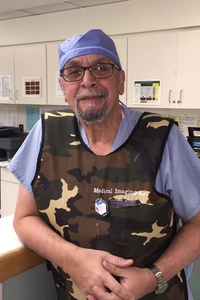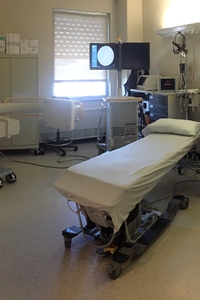Pain Clinic
OSF St. Mary Medical Center offers non-narcotic treatment of chronic pain by Dr. Afram. He is a pain specialist, trained in the field of anesthesiology that focuses on the diagnosis and management of chronic pain. Dr. Afram performs procedures using steroids injections, nerve blocks, or spinal cord stimulators to decrease pain related to specific regions of the body.
 Dr. Hany Afram
Dr. Hany Afram
 Procedure Room
Procedure Room
Procedure list for Pain Clinic
Epidural steroid injections
The epidural steroid injection (ESI) is a minimally invasive procedure used to help relieve neck, arm, back and leg pain due to inflamed spinal nerves. X-ray (fluoroscopy) is used to assist in guiding the needle to the location needing treatment, by injection a steroid close to the inflamed area the medicine can help to lower inflammation and thereby reduce pain. The effect of an ESI give temporary relief that can last for days, weeks, or months. The goal in performing an ESI is to decrease pain in order for the patient to resume normal activities.
Facet Injections and Medial Branch Blocks
- Cervical
- Thoracic
- Lumbar
- Sacral
The facet joints are located on either side of each vertebra “back bone” of the spine. These joint allow the spine to bend and twist. As people age these joint can become arthritic and inflamed causing pain to the neck that radiates into the shoulder or low back pain radiating into the buttocks and upper thighs. Usually this pain is located on one side and involves more than one level. Using x-ray (fluoroscopy) steroids and a small amount of local can be injected directly into the joint or more often the small medial branch nerves that are connected to a specific facet joint. This is a diagnostic test and the injection can last a few hours to few days, at the most. This is normal. This injection is performed as an indicator of success before radiofrequency lesioning of these nerves is considered.
Radiofrequency Nerve Ablation
- Sacral
- Hip
- Knee
Radiofrequency lesioning is a procedure in which the nerve or nerves identified as transmitting a pain signal to the brain are interrupted to relieve pain. This is a minimally invasive procedure and is performed using a probe that helps identify the nerve location and then is heated to interrupt the pain signal. Before consideration for this procedure the patient must first have a successful block using local anesthetic and steroid of the identified nerve or nerves. Recovery time is short and patients can return to work within 24 -40 hours.
Nerve Blocks
-
Greater Occipital Nerve Block
An occipital nerve block is an injection of a steroid or other medication around the greater and lesser occipital nerves that are located on the back of the head just above the neck area to help diagnose and treat certain kinds of head pain. - Intercostal Nerve Block
This injection is done to help with rib pain due to trauma such as rib fractures or from repetitive injuries such as coughing. To relieve pain, the intercostal nerve that run along underside of the rib is injected with local anesthetic and a steroid. Relief is quick, but can be temporary and require a series of injections. - Lateral Cutaneous Nerve Block
The lateral femoral cutaneous nerve, in general, provides sensation to the outer and frontal side of the thigh. When inflamed a person can experience pain with tingling or numbness to this area. The pain is made worse when sitting or squatting for long periods. This pain may also occur due to compression of the nerve by wide belts, tool pouches or during pregnancy. To relieve pain, the nerve is injected with local anesthetic and a steroid. Relied is quick, but may be temporary and require a series of injections. - Ilioinguinal Nerve Block
The ilioinguinal nerve, in general, provides sensation to the upper portion of the skin of the inner thigh, and in men, the root of the penis and upper scrotum, and in women, portions of the pubic area. Ilioinguinal nerve block with local anesthetic and steroids is useful in the treatment of persistent pain after inguinal surgery or groin trauma when the pain is thought to be due to inflammation or entrapment of the nerve - Genicular (Knee) nerve Block
- Sensory Branch of the Obturator & Femoral (Hip) Nerve Block
This block is performed using x-ray (fluoroscopy) with the specific intention of testing the sensory nerves surrounding either the hip or knee to determine if further treatment using radiofrequency lesioning would be successful. Hip and Knee pain due to osteoarthritis is a major cause of disability in older adults. Patients who do not respond to conservative treatment or continue to have pain following arthroplasty (replacement) of the joint are candidates to this injection and the radiofrequency procedure that follows successful testing.
Sacroiliac (SI) Joint Injection
The sacroiliac (SI) joint is located in the pelvis, linking the iliac bone (pelvis) to the sacrum (lowest part of the spine above the tailbone). This joint transfers weight between your upper body and legs and is essential during walking. Dysfunction in the sacroiliac joint presents as low back and/or leg pain. The leg pain can be particularly difficult, and may feel similar to sciatica or pain caused by a lumbar disc herniation. X-ray (fluoroscopy) is used to guide the needle into the joint at which time local anesthetic and a steroid are injected.
Trigger Point Injections
A trigger point is a “knot” that is formed when bands of muscle become tight. This condition causes intense discomfort and can restrict movement. Trigger points most commonly develop in the neck, lower back, arms, and legs. Immediate relief of pain can be done by injecting the trigger point using local anesthetic and a steroid.
Bursa Injections
- Trochanteric Hip Bursa
- Subacromial shoulder Bursa
A bursa is a fluid-filled sac that the body uses to countering friction at a joint. When the
bursa becomes inflamed it is known as a condition called bursitis which can make movement of the joint painful. The most commonly effected joints are the hip and shoulder. If this inflammation does not respond to conservative treatment as steroid can be injection to reduce the inflammation quickly.
Sympathetic Nerve Blocks
This type of injection is used to target problems with the sympathetic nerves that spread out from the spine to different parts of your body. These nerves control involuntary bodily functions including blood flow, digestion, and sweating. The location of your pain determines location of the injection and which nerves will be blocked. Many times this injection is used for a condition known as complex Regional Pain Syndrome also called Reflex Sympathetic Dystrophy.
Spinal Cord Stimulation
-
Spinal cord stimulation is a treatment for chronic pain in which leads that uses a mild electric current are implanted into the spine to block painful nerve impulses to the brain. The leads are then connected to a generator (battery) that is implanted under the skin. Your physician will have to evaluate your pain to see if you are a candidate for this type of procedure. This procedure is indicated for patients whose back pain continues or gets worse, even after surgery to correct it, complex regional pain syndrome, and long-term (chronic) back pain, with or without arm or leg pain. Patients who have this procedure may have less back pain and need to take fewer pain medications. Prior authorization from your insurance company is required and permanent implantation is done only after a trial of spinal cord stimulation is successful.
To make an appointment with the pain clinic please have your physician contact us and send any medical record discussing your pain status, list of medications, any diagnostic imaging (x-ray, MRI or CT), and EMG.

